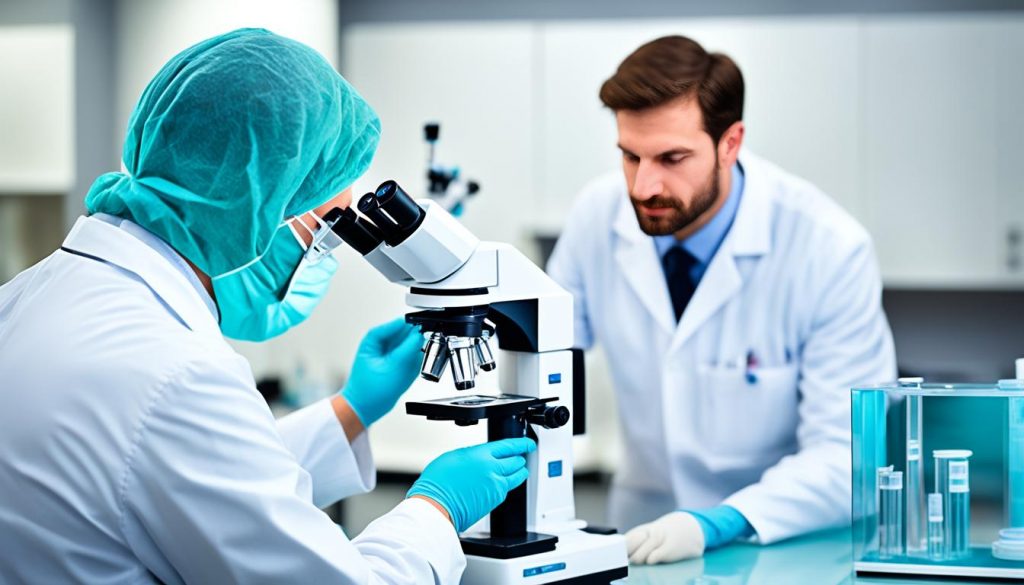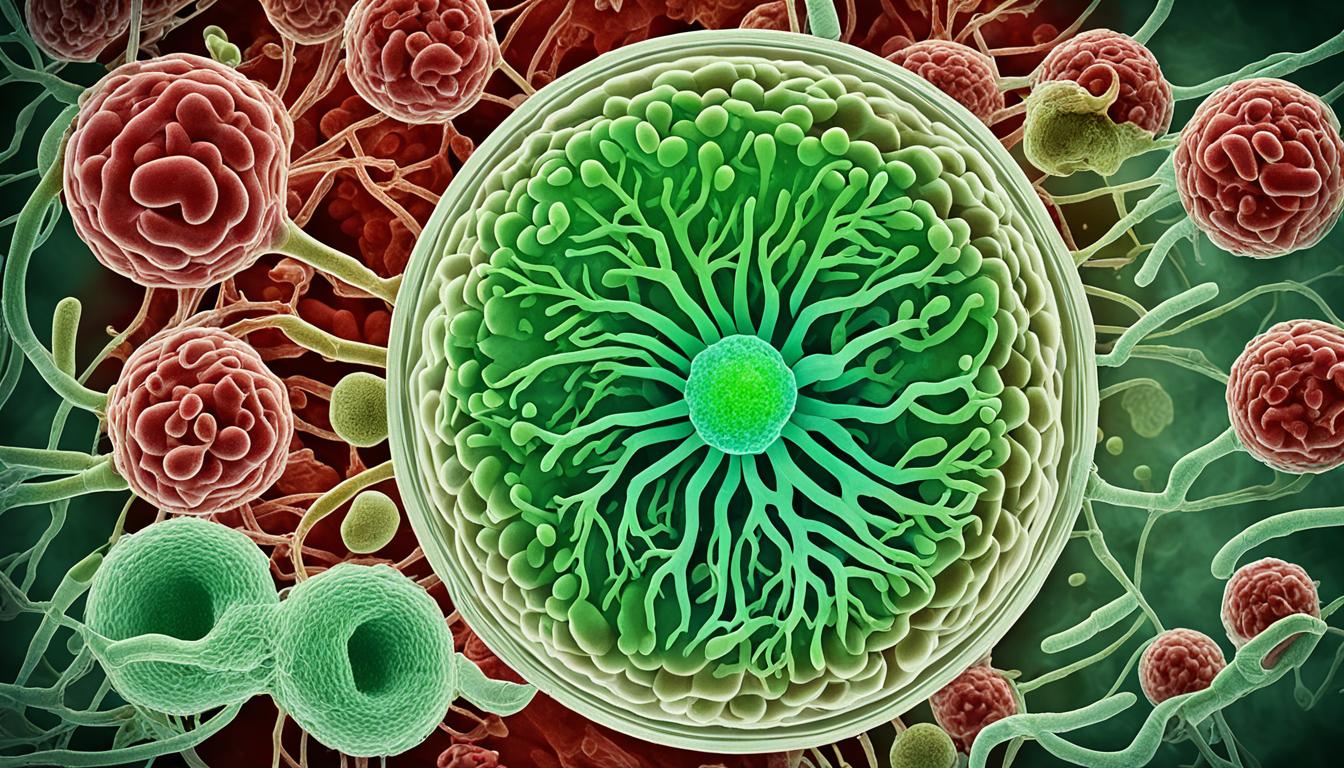Blastocystosis is a condition caused by the Blastocystis parasite. It’s common around the world, but more so in less developed countries. We’ll look at what symptoms it causes, how it’s caused, how to diagnose it, and how to treat it. We will also explore the role of stem cell therapy.
People with Blastocystosis might experience symptoms like diarrhea, stomach pain, tiredness, constipation, and IBS. It can affect anyone, regardless of their immune system’s strength. Finding and treating it is key to reduce symptoms and avoid further health issues.
Blastocystosis happens when someone ingests Blastocystis cysts found in dirty food, water, or on surfaces. Not following good hygiene, living in crowded places, traveling to areas where it’s common, or having a weak immune system increases the risk.
To diagnose it, doctors check a stool sample for Blastocystis. They might use a microscope, grow the parasite in a lab, or test its DNA. One should always consult a healthcare expert to get the right tests and diagnosis.
The usual treatment includes antibiotics and drugs against parasites. But, there’s a new option on the rise: stem cell therapy. Stem cells can fix damaged tissue and help beat Blastocystosis. Thailand is at the forefront of this exciting therapy, attracting patients from all over.
Key Takeaways:
- Blastocystosis is a parasitic infection caused by the Blastocystis protozoan parasite.
- Common symptoms include diarrhea, abdominal pain, fatigue, and constipation.
- Contaminated food, water, and poor hygiene contribute to the transmission of Blastocystosis.
- Diagnosis is done through stool examination using microscopy, culture, and molecular methods.
- Treatment options include antibiotics, antiparasitic medications, and stem cell therapy.
Symptoms of Blastocystosis
The signs of Blastocystosis range from mild to severe. People often report diarrhea, stomach pain, bloating, tiredness, and constipation. They also might feel symptoms of irritable bowel syndrome (IBS). Some may even have skin rash or urticaria.
Note that Blastocystis can be in both people who feel sick and those who don’t. Thus, figuring out symptoms can be tricky. It’s vital to get a proper diagnosis and treatment to feel better and avoid more issues.
Blastocystosis affects people differently. Some only feel a little uncomfortable, while others have tougher symptoms. Diarrhea, stomach pain, bloating, tiredness, constipation, and IBS are common. These issues can really affect someone’s life and daily tasks.
Apart from stomach issues, some people may get skin rashes or urticaria. This shows the body is reacting to the parasite. These outside symptoms make it harder to understand Blastocystosis, making a good diagnosis and treatment even more important.
Finding Blastocystis in both those with and without symptoms shows it’s complicated. This highlights why it’s tricky to nail down symptoms of Blastocystosis. Always talk to a doctor for a correct diagnosis and to rule out other possible causes.
LIST: Symptoms of Blastocystosis
- Diarrhea
- Abdominal pain
- Bloating
- Fatigue
- Constipation
- Irritable bowel syndrome (IBS)
- Extra-intestinal manifestations such as skin rash or urticaria
Getting the right diagnosis and treatment is crucial to manage symptoms and stop more problems with Blastocystosis. The next part will cover the causes of Blastocystosis, showing how people get and spread the infection.
Causes of Blastocystosis
Blastocystosis comes from eating Blastocystis cysts. These cysts are forms of the parasite that spread infection. The main way it spreads is through fecal-oral route. This route happens in places with poor cleanliness or crowded spots.
Dirty food, water, and places can have Blastocystis cysts. This makes them ways to get the infection. It can also spread from animals to people and from one person to another. This can make more people sick. People with weak immune systems are more likely to get it.
To lessen the chance of getting Blastocystosis, cleanliness and safe food and water are crucial. Wash hands well with soap and water before touching food. Use clean water and cook food right. Also, stay away from dirty surfaces, especially in busy areas, to avoid getting sick.
Knowing the dangers and taking steps to avoid them is key in fighting Blastocystosis. Being clean and keeping places clean are important to stop this parasite from spreading.
Risk factors for Blastocystosis
| Risk Factors | Description |
|---|---|
| Poor hygiene and sanitation practices | Lack of proper sanitation facilities and hygiene practices contribute to the spread of Blastocystosis. |
| Crowded or unsanitary conditions | Living in crowded or unsanitary environments increases the risk of infection. |
| Traveling to endemic regions | Visiting areas with a high prevalence of Blastocystis increases the likelihood of exposure and infection. |
| Weakened immune system | Individuals with weakened immune systems are more susceptible to acquiring Blastocystosis. |
Diagnosis of Blastocystosis
To find out if someone has Blastocystosis, doctors use different ways to see Blastocystis in poop samples. They use methods like:
- Microscopy: By looking at poop samples under a microscope and staining them, doctors can spot Blastocystis. This includes seeing cysts or trophozoites. It’s a key step for figuring out if someone has the infection.
- Culture: Doctors can also grow the Blastocystis from a poop sample in the lab. This helps them learn more about the infection and confirm it.
- Molecular methods: A very accurate test called PCR looks for Blastocystis DNA. By doing this, doctors can know not just if it’s there, but also what type. This info helps in choosing the best treatment.
Getting a correct diagnosis of Blastocystosis means the poop sample must be collected and handled right. It’s crucial to follow the steps doctors give to get trustworthy test results. If you think you might have this infection, see a healthcare professional. They will guide you on the best tests based on what you’re experiencing.

Stem cell therapy for Blastocystosis
Stem cell therapy is a new approach that shows potential for treating Blastocystosis. Stem cells can regenerate and turn into various types of cells. This makes them ideal for fixing damaged tissues and improving the immune system.
In Blastocystosis cases, this therapy aims to repair the intestines and boost the body’s defenses against the infection.
Thailand is known for its top-notch stem cell treatment centers and skilled doctors. It draws patients globally seeking advanced treatments. With the best technology and experts, Thailand provides a great setting for those considering stem cell therapy for Blastocystosis.
Stem cell therapy for Blastocystosis is promising but still experimental. More research is needed to confirm its safety and how well it works. Still, the possibility of stem cell therapy treating various diseases is exciting. It offers hope to those with Blastocystosis and other tough illnesses.
Advantages of stem cell therapy for Blastocystosis
Stem cell therapy for Blastocystosis has several benefits:
- Promotes tissue regeneration: It can turn into diverse cell types to fix and renew damaged intestinal tissues, speeding up recovery.
- Enhances the immune system: Stem cells can improve the body’s immune response to combat the Blastocystis infection.
- Minimally invasive procedure: It’s usually done through minimally invasive methods, lessening complication risks and aiding quicker recovery.
- Potential for long-term benefits: Successful therapy might offer lasting results and lower the chance of the disease coming back.
Future prospects and challenges
Though stem cell therapy for Blastocystosis is hopeful, there are still challenges:
- Standardization: It’s vital to have standard protocols and guidelines for consistent results in different therapy centers.
- Safety concerns: The safety of this new treatment must be thoroughly tested through research and clinical trials.
- Accessibility and affordability: The therapy needs to be more accessible and affordable for more patients to benefit from it.
- Regulatory considerations: Clear rules and ethical guidelines are necessary for using stem cell therapy safely for Blastocystosis.
Despite the hurdles, stem cell therapy remains a promising option for treating Blastocystosis. Further research and improvements could lead to more effective therapies, giving hope to those fighting this infection.
Prevention of Blastocystosis
Preventing Blastocystosis is key to reducing infection risk. Proper hygiene and sanitation can help a lot. Here are important steps to take:
1. Maintain good hand hygiene
Washing hands well with soap and water is critical. Do it before you eat or make food. It helps remove potential contaminants, lowering infection chances.
2. Use clean and safe water sources
Make sure your water for drinking and cooking is from a safe source. Don’t use water that could be contaminated, as it might have Blastocystis cysts.
3. Properly handle and cook food
Always wash raw produce, meat, or seafood well before cooking. Cook food, especially meat, to the right temperatures to kill parasites or bacteria.
4. Avoid contact with contaminated surfaces
Be careful with surfaces that might have Blastocystis cysts, like in public areas. Avoid touching them directly. Always clean and disinfect surfaces you touch often, both at home and in public.
5. Follow food and water safety guidelines while traveling
Take extra care if you travel to places with higher Blastocystosis cases. Eat only safe, cooked food and drink bottled or boiled water. Stay away from raw or street food that might be unclean.
6. Consult healthcare providers for immunocompromised individuals
People with weak immune systems should talk to their doctors for more advice. This includes those on chemotherapy or with certain medical conditions. They may need special advice or medicine to lower their infection risk.
By taking these preventive steps, you can greatly lower your Blastocystosis risk. Staying proactive about hygiene and sanitation is crucial for health and safety.
Conclusion
Blastocystosis is a widespread parasitic infection. It’s caused by Blastocystis, a protozoan parasite. This condition is more common in developing countries. It presents various symptoms, making timely diagnosis vital for choosing the right treatment.
To diagnose Blastocystosis, doctors often use stool tests. These tests help find Blastocystis cysts. For treating the infection, options include antibiotics and antiparasitic drugs. There’s also stem cell therapy, which is still being tested. This new method might repair tissues and strengthen the immune system.
Thailand is known for its advanced stem cell therapy for Blastocystosis. For prevention, cleanliness, proper sanitation, and safe food and water practices are crucial. More research will help us understand and treat Blastocystosis better. This work is key to improving how we manage this infection.

